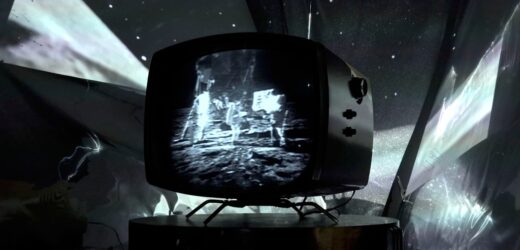Gary Emrich’s “Dibs” is a monumental work by one of Colorado’s most prolific and respected artists, the culmination of eight years of dedicated labor that concludes his three-part video series known as the “Apollo Trilogy.”
The 16-minute video, now showing at Robischon Gallery, is a non-linear collage of dynamic images and sounds that sprawls across three screens. It is a dreamy, urgent and, ultimately, dark take on the American spirit as it exists today.
Like the two previous videos in the series, Emrich looks to the 1969 lunar landing orchestrated by NASA to show us all that we can be, and the things we lack. Through this filter, the Apollo 11 mission was the ultimate show of daring, cooperation and American exceptionalism.
If you go
Gary Emrich’s “Dibs” screens at Robischon Gallery through Dec. 31. It’s free. Info at robischongallery.com.
But it also was the beginning of the end, the final chapter of our manifest destiny — before we came to grips with the indecencies of colonialism, and before we dissembled into factions and started nibbling on the sort of sinister conspiracy theories that lately have become a poisonous feast.
The lunar landing generated one of the first great conspiracy theories of our time. People claimed it was a hoax because the flag that was planted by visiting astronauts appeared to be waving in a landscape with no wind. How could that be? The truth, of course, is that it was constructed to behave that way, a prop for the massive TV show that the landmark event became.
That act is central to Emrich’s piece — and the cause for its title — as the astronauts erected their flag, symbolically claiming the terrain for the United States. He projects it on the largest of the three screens at Robischon, borrowing black-and-white footage captured by actual NASA cameras.
All these years later, it is still mesmerizing, even gleeful, to watch, not just the forbidding landscape but the behavior of the astronauts themselves, bouncing up and down like children, giddy at their own accomplishment, mirroring the pride shared by the entire country.
Emrich enhances the original visuals, editing in red and white stripes that shoot off the flag, and mixing in other imagery, in one case a painting of cowboys on horseback, riding gallantly along the range. There is a self-congratulating connecting of the dots between expansionism old and new.
No doubt, there is a dark side to this moon landing, and Emrich instills the room with it. There is a vastness to his celestial landscape that suggests space is unconquerable and this mighty mission is in vain, a foolish, high-tech exercise in old-school imperialism from the get-go.
He surrounds that with more doubt. On a second screen, he projects videos that he took over the past five years of American monuments, of political rallies and industrial scenes. In the foreground of each of these scenes, all of which hint at division or planetary destruction, he plants his own flag — a tiny, flapping version of Old Glory that suggests this is the America we celebrate now.
On the third screen, the smallest of all, he displays abstracted images of rodeo riders being ejected, again and again, from bucking bulls. The message: The natural world is untamable, no matter how hard a cowboy tries. Sound artist Goran Vejvoda collaborated on the audio, which includes, colorfully, snippets of music from the “Bonanza” television series and the old Marlboro cigarettes jingle.
“Dibs” is a complex, multi-layered understanding of how this country has evolved, and it sums up well the overall trilogy, which began with 2013’s “Contact,” a simpler, one-channel video that sets images of the moon and a soundtrack of mission control audio alongside a busy hive of honey bees. The video was kept on display for eight months at the Denver Art Museum.
(Emerich has appeared in a whopping, and possibly unparalleled, string of 11 exhibits at DAM, going back to 1981).
“Contact” was followed by his two-channel “Splashdown” in 2018, which contrasted vintage scenes and headlines from the Apollo landing (American triumph) with images and symbols of the deadly automobile accident famously referred to as “Chappaquiddick” that derailed the political career of Ted Kennedy (American tragedy). The two incidents unfolded only two days apart.
What’s striking about the trilogy, beyond the chop of visuals, is its roundness. The three parts do come together to tell a story — despite their lack of clear narratives — but they rarely overlap, taking on separate themes of industriousness, risk and reward, futility, hopefulness and disaster. Emrich kept his eyes on the prize for a very long time, and that alone is an accomplishment.
Projects like the “Apollo Trilogy” are labors of love for an artist like Emrich. He’s a successful photographer who makes his living off the work he makes. He has exhibited at museums and galleries near and far and has maintained a successful relationship with Robischon, the city’s top contemporary commercial gallery, for many years.
But videos are barely hot commodities in the current art market. They rarely sell. That is especially true for a three-channel piece, such as “Dibs,” which requires considerable space to show.
Its creation comes down to commitment, or obsession, or possibly desperation on the part of an artist to find a way to express ideas, in this case political ones. It’s the essence of a certain kind of art-making that stands apart from any potential to bring riches or renown to its maker.
Unlike material objects, such as paintings and sculpture, videos don’t exist unless they are being screened. They disappear. One hopes this particular trilogy will be screened in the future. It’s a museum-quality piece waiting to be scooped up by a museum, and it’s not so hard to see an ambitious curator showing all three videos simultaneously in adjacent rooms during a single exhibition.
In the meantime, there are a few weeks left to experience the third part at Robischon and to catch up with the previous two on Emrich’s website (garyemrich.com). Watch them first before heading over to the gallery.
Subscribe to our weekly newsletter, In The Know, to get entertainment news sent straight to your inbox.
Source: Read Full Article






